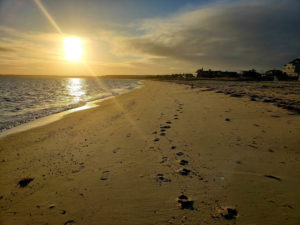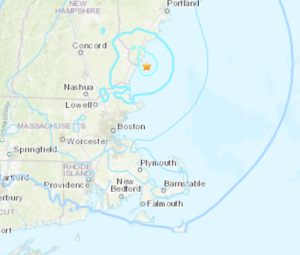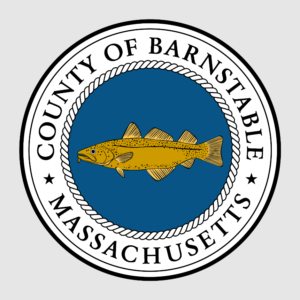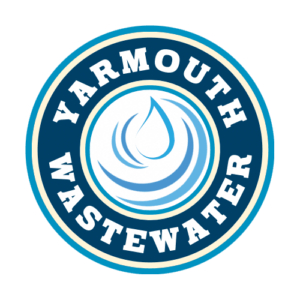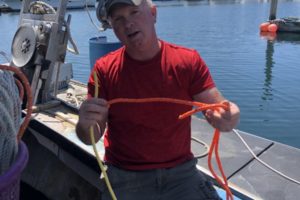 CHATHAM – Rob Martin was five miles out on his boat, Resolve, lobstering with his crew, and made a call on his way back to port.
CHATHAM – Rob Martin was five miles out on his boat, Resolve, lobstering with his crew, and made a call on his way back to port.
Martin wasn’t calling his buyer. He was joining a conference call for the National Oceanic and Atmospheric Administration’s Atlantic Large Whale Take Reduction Team, of which he is a member.
Martin intended to just listen, but they started talking about gear modifications, which he knows a good deal about.
They asked him to chime in as he was offloading, but there was quite a bit of background noise on his end.
“Can you hold on a second? I have to shut the boat down,” he remembers asking. “Actual fisherman here out fishing and coming in to talk!”
The conversation revolved around installing breakaway sleeves in vertical lines from traps to buoys so whales can snap them on contact and not become entangled.
Martin wasn’t required to make those changes, but he already had. He has been working for years to find a way to continue fishing and protect whales, like other proactive lobstermen. So when managers and others first started talking about “breakaway” lines he took the hint and started retrofitting his gear. In the 1990s, when regulators were looking at sinking lines to help avoid whales, he got ahead of that too. Sinking lines, weighted to drop to the bottom if they break free, are now a requirement.
Martin and others spent time talking to scientists at the New England Aquarium who had studied what whales could clear without getting entangled.
“We used the best available science,” Martin said.
Sleeves of rope, which snap with 1700 pounds of pressure, are installed every 40 feet. That’s 480 sleeves over several miles of rope.
“I saw the writing on the wall and if I’m preaching it I’m going to do it,” he said.
Massachusetts lobstermen have been taking action for years so when the most recent regulations were agreed upon by the Take Reduction Team, state lobstermen received some credit for areas they no longer fish.
Some states, such as Maine, didn’t support closed areas and will have to reduce lines in the water by 50 percent to help avoid whale mortality. How those reductions are going to be achieved will be discussed throughout the summer.
The Atlantic Whale Take Reduction Plan went into effect in 1997, updated close to a dozen times since. The majority of the plan revolved around gear modifications and closing areas where right whales are observed or expected.
Martin has worked on gear modifications in hopes they can get back into some closed areas, particularly where whales have not been observed. Over time he thinks that he has lost about 25 percent of his income.
But things could get worse. Lobstermen as well as those in other pot and gillnet fisheries are waiting on an opinion from the National Marine Fisheries Service as to whether any lines in the water puts the right whale in “jeopardy.” That decision, made under the Endangered Species Act, triggers alternatives from modifying the gear to shutting down the industry.
The take reduction team was only expected to meet every five years, but with more than a dozen documented deaths of right whales in 2017 that has changed. Entanglement in fishing gear and collisions with ships have been primary causes of whale injuries and deaths. But in 2017 the vast majority of deaths occurred in Canadian waters as right whales have shifted habitats, and Canadians had not yet employed more whale-friendly gear.
Martin was appointed to the take reduction team a year ago, but he is no stranger to their role.
“If you aren’t at the table, prepare to get served,” he is fond of saying.
He has been lobstering since he was about 12 years old growing up in Plymouth, has had Resolve for close to 30 years.
“I’ve been fishing almost 40 years, now that’s scary,” he said.
When he first got a student license, he was working his own pots close to shore.
“I would row out in my dinghy,” he remembered. After a day on the water, he would row back in, spending nights at a renovated fishing shack along the shore while his parents worked on the mainland. People knew the young Martin had lobsters so they would stop by the cottage.
“Or I would sell my lobsters on the beach,” he said.
When he graduated Plymouth Carver High School he headed to the University of Rhode Island to pursue a degree in fisheries and marine technology. He spent a lot of time at the Point Judith docks in Rhode Island, picking up work on fishing boats, and he also had his own boat – a 19-foot Novi. Martin ended up leaving college.
“I already knew what I was going to do,” Martin said.
He bought an old wooden boat, then a new boat, coming to the Cape to start a family. But that investment was shortlived.
“The boat exploded one night,” he said. “The boat was a year old at the time.”
The next boat he has kept, and he has stayed in Sandwich.
“The steam (to good fishing areas) is longer (than Plymouth) but it’s really well protected,” he said. Martin likes the captains around him and sells some of his catch to Fishermen’s View, a restaurant he can see from his slip and enjoys frequenting.
He has done some scalloping with the Resolve, has gone hook fishing and worked on a dragger, but lobstering has always been the center of his world.
And he has a lot of help from his wife, Lori Caron, a fount of information on regulations and business matters (as well as navigator for the Massachusetts Fisherman’s Partnership).
She got to know him before she found out what he did for a living. “I would have never dated a fisherman,” she smiled.
He has found he enjoys connecting with scientists. Recently he had a research assistant onboard installing a temperature gauge and he has worked with the Provincetown Center for Coastal Studies retrieving so called “ghost gear” from the ocean.
He is also working with researchers from the Northeast Science Center on acoustic buoys – or ropeless fishing. The concept seems to work with single pot traps, but so far hasn’t translated well into trawl fishing, when many pots are lined up together.
“We are messing around with a few things,” he said.
But this is the time of year when the lobstering picks up.
“Fourth of July is crazy,” he said.
With a wholesale license and a tank on the porch, people come by just like they did when he was 14 years old.
That, at least, hasn’t changed.






